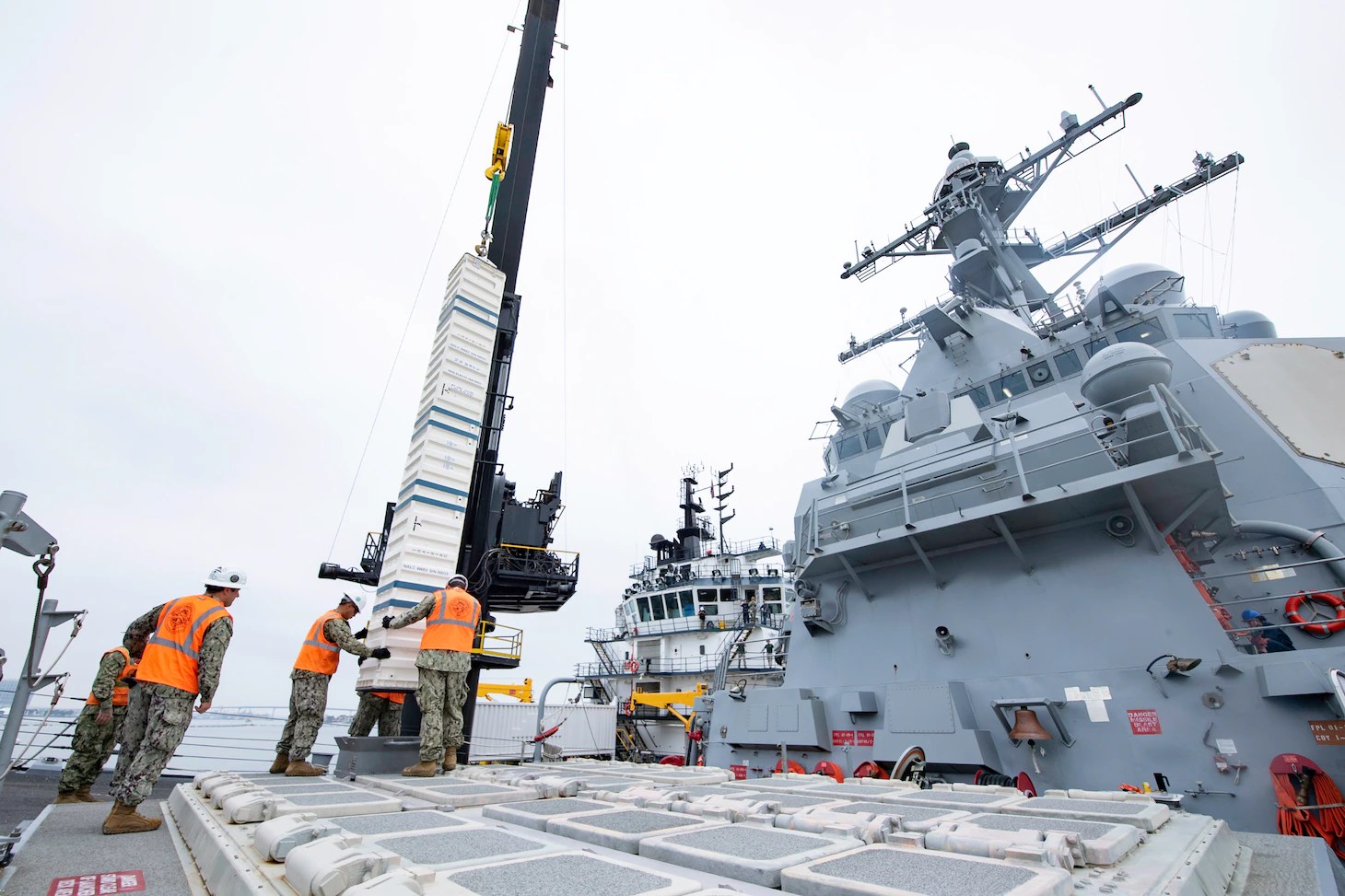To make up for its range, logistics, and sustainability disadvantage before the People’s Liberation Army Navy (PLAN) in the western Pacific, the United States Navy (USN) tried exploiting its ‘payload’ advantage using civilian support vessels last week.
With the help of an Offshore Support Vessel (OSV), MV Ocean Valour, the USN reloaded the Vertical Launch System (VLS) cells of a frontline Arleigh Burke-class USS Spruance destroyer.
The capability ensures sustained combat operations in the sea, which might require a high volume of continuous fires, especially in long-drawn-out wars. US military leaders have repeatedly admitted their handicaps before a well-prepared China in the Western Pacific, where it enjoys a home advantage.
Closer to its mainland and defense industry, China can rapidly churn out ammunition, repairs, and war machines in case of a protracted/long war to make up for possible initial massive losses in the outbreak of a conflict.
On the other hand, the US is far from its homeland and faces basing issues with even friendly nations in the Western Pacific.
Many of these are indeed distressed by China’s growing military and financial might but are ambivalent in taking a hardline and joining a military alliance with the US owing to their deep economic ties to Beijing. China is also central to the economy and industry in the far east and southeast Asia.
US Handicaps Before China In The Western Pacific
In case of a short war, China has long been expected to achieve its military aims with its ultra-long range Anti-Access/Area Denial (A2/AD) weapons, purported to keep an invading US force away from the mainland.
The Chinese YJ-18 anti-ship cruise missiles (range 540 kilometers) carried by the Type 052 and Type 055 destroyers and the PL-15 Beyond Visual Range air-to-air missile (300 kilometers) outranges the US’ 240-kilometer range Harpoons and the 161-kilometer AIM 190D.

Harpoon Anti-Ship Missiles (AShM) are carried by the US Arleigh Burke destroyers and the Ticonderoga-class cruisers. Even the Standard Missile-6 (SM-6) has limited land attack capability and can reach only up to 240 kilometers.
The DF-21D Anti-Ship Ballistic Missile (ASBM) – called China’s “carrier-killer” – threatens US aircraft carriers, given its unorthodox ballistic path, which experts agree does not have any defense system designed to tackle the unconventional approach.
The former commander of the US Pacific Command (now Indo Pacific Command or INDOPACOM), Admiral Harry Harris, admitted China’s lead in long-range missilery before the Senate Armed Services Committee in March 2018.
“We are at a disadvantage concerning China today because China has ground-based ballistic missiles that threaten our basing in the western Pacific and our ships,” he said.
Eurasian Times had reported that current US Marine Corps Assistant Commandant General Eric Smith admitted in an interaction with the Stimson Center about the “wicked” logistics problems in the western Pacific before China that impeded conducting a sustained military campaign. Wargames conducted by the RAND Corporation for the Pentagon has also repeatedly ended in devastating US and Taiwanese defeats before swarms of thousands of Chinese missiles, boats (both military and civilian), drones, jets, and other naval craft.
Mid-Sea Rearmament – The US Exploiting Its Capacity & Payload Advantage
Bryan Clark, a Senior Fellow and Director of the Hudson Institute, said that the longer ranges of Chinese missiles disallow the USN from exploiting its payload and capacity advantage, where its warships carry more missiles. “If the Chinese side can launch at longer ranges, then the missiles on the US side are irrelevant if China fires first from outside the range of the US warships. What could US ships be launching in response? At the ranges we are talking about, nothing,” Clark was quoted in an article in Business Insider.
PLAN’s Type 052 and Type 055 destroyers have 64 and 112 Vertical Launch Systems (VLS) cells, respectively, while the USN destroyers and cruisers have 96 and 112. Thus, China lacks the ‘heavy lifters’ that can mass fire to overwhelm US ships and get through their defenses.
But this capacity disadvantage is made irrelevant by the “range, speed and sensor performance” of China’s anti-ship missile capability that “exceeds” that of the United States, former Marine Corps officer and Visiting Senior Fellow at the Mitchell Institute for Aerospace Studies told Reuters.
The latest exercise by the Military Sealift Command from October 4 to October 7 further enhances this payload advantage to an even more decisive level, assuming the range and logistical issues hopefully tackled by the time a war breaks out.
Conducted at Naval Air Station in San Diego Harbour from October 4 to October 7, it was the first time the Navy has tested VLS reloading from an offshore support vessel platform – the MV Ocean Valour.
“The demonstration is being conducted to prove that an offshore support vessel can reload the weapons system pier side and while the ship is at sea, to expand the capability of VLS reloading in expeditionary environments,” said a statement from the USN.
Interestingly, the launch system reloads have been tested previously, in 2016 and 2019, using other Military Sealift Command platforms.
- The author can be reached at satamp@gmail.com
- Follow EurAsian Times on Google News